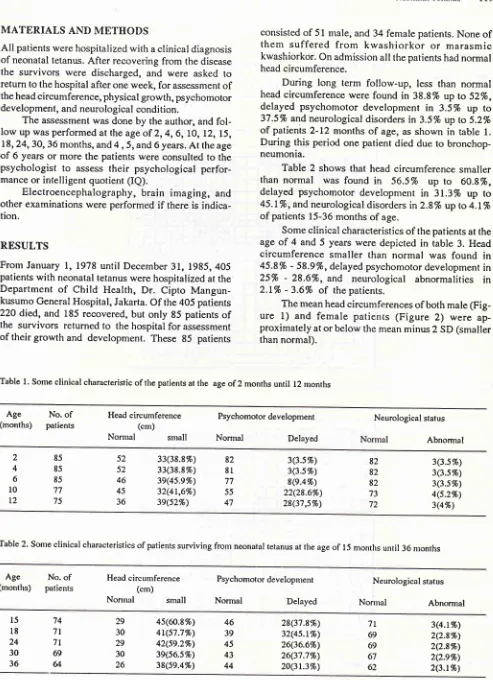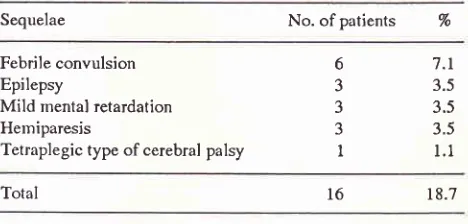I
l8
Soetonenggolo Med J IndonesLong-term
Follo\ry
up
on
Patients
with
Neonatal Tetanus
Taslim
S.Soetomenggolo
Abstrak
Seiak tanggal
I Januari
1978 sanpai dengan tanggalil
Desenùer 1985, di Bagian Ilnu Kesehatan Analç Runah Sakit lJtnuntDr.
Cipto Mangunkusunto, Jakarla, telah dirawat penderita tetanus neonatorur,, sebanyak 405 bayi. Selana perawatan, 220 bayi ueninggal dunia dan 185 bayi senbuh, tetapi hanya 85 bayi seuùuh yang keubalikontol
ke rutnah sakit untuk penilaian pertut1buhandan perkenbangann a. Delapan puluh
lina bayi tersebut
terdiri dari5I laki-laki, dan
34 perenpuan. Selanru pengamatan tidak ada yang nenderita kv'ashiorkor atau kv,ashiorkor narasnik. Mikrosefali didapatkan sebanyak 38,8% pada wnur 2 dan 4 bulan, dan 60,8%pada uuur 15 bulan. Perkeubangan psikon,otor terlaubat ditenulun pada 3,5% bayi, pa.da untur 2 dan 4 bulan, dan 45% pada
unur
l8 bulan. Tidak seuua penderita dengan
uikrosefali nengalani keterlanbatan perkenbangan psikouotor. Sebagian besar penderita nenderita nikrosefali. Junlah penderita dengan IQ nornal lebih sedikit daripada populasi nonnal, dan IQ di bawah nonnal ditenukan lebih banyak daripada populosi nornal. Gejala sisa terdapatpada
18,7% penderita, terdiri dari kejang detnant, epilepsi, retardasi nental ringan, heniparesis, dan palsi serebaljenis tetraplegi.Abstract
Between January
I,
1978 and Decenber 3I,
1985, 405 patients with neonatal tetanus were hospitalized at the Deparnnent of Child Heahh, Dr. Cipto Mangunkusutuo General Hospital, Jakarta. Of the 405 patients 220 died and 185 recovered, but only 85 patiennof
the sun'ivors agreed to retu rnfor
d.ssesslren, of their grou,th and developnent. Of the 85 patients 5I
v,ere tnales, and 34 were fennles. During follow uP none u'ere found to sufferfron
kwashiorkor or nwasnic ku,ashiorkor. Microcephaly v,asfowvl
in
38.8% at the ageof 2 and 4 nonlhs, and 60.8% at the age of 15 nonths. Deloyed psl'choilotor developttrcnt was as.se.s.sed b1, using Mulchen and DDST,
and it wasfouttd as low as 3.5% at the age of 2 and 4 nonths to as high as 45% at the age of 18 tttonths. Not
all
patients with nicrocephaly sufferedfrou delai-ed ps1'chomotor developnent. The ntean head circwnference of male andfennle parients lay at or below tneanininus 2 SD, neaning uost of the patients sufferedfron nicrocephab,. The nwnber of patients with nonnalIe
is less than the nonnal populatiol, and slow learner cates, coses u'ith borderline ntental rerardation, and nild nental retardation are nrore nut,rerous îhan the nornal population. Ofùe
85 Patienlsfolbv,ed
the sequelae u,ere 18.7%, consisting offebrite
convulsion, epilepsy, nùld nental retardatian,hetniparesis, and tetraplegic 1'pe ofcercbral palsy, but the cerebral palsy n1a, be due to kernicterus.
Keywords : Neonatal tetanus, head circunrference, psl,chotnotor developtilent, neurological disorders.
INTRODUCTION
Generalized
convulsive
spasms, associated
with
cyanosis and apnea and consequently
with
brain
hypoxia
are
a
common and
severedisorder
found
in
neonatal tetanus.
It
is generally
believed
thal
tetanusdoes
not
leave neurological sequelael,
but
some
studies
found about
10%
caseswith neurological
se-quelae2'3, and brain necropsy showed severedég.n".u-tion or
disappearance
of
the
neuron. Significant
neurological
sequelaewere found
in
4 out
of
9
sur-vivors4,
mild
mental retardation
werefound in
2 outof
43
survivors
aly and mentaldefect
were
vors6,and
ap-preciable
ha
ivors'.
All
theneurological
sequelae
were found
in
patients with
severeneonatal
tetanus.Brain growth
andpsychomo-tor
development in
_children
also
depend
on thenutritional
condition'.
Head circumference
was
smaller
in
patients
with
marasmic kwashiorkor.
The
aim of
thisstudy
is to assess the head circum-ference,psychomolor development,
and theneurologi-cal disorders
of
thesurvivor of
theneonatal
tetanus.Vol 4, No 2, April-June, 1995
MATERIALS
AND METHODS
All
patients werehospitalized
with
aclinical
diagnosis
of
neonatal
tetanus.After
recovering
from
the diseasethe survivors were discharged, and were asked
to
return
to thehospital
after one week,for
assessmentof
the headcircumference, physical growth, psychomotor
development,
andneurological condition.
The
assessment was doneby
theauthor,
andfol-low
up
wasperformed
atthe
ageof
2,4,6,
lO, 12,
lS,
18,24,30,
36 months, and 4 , 5, and 6 years.At
the ageof
6
yearsor
more
thepatients were consulted
to
thepsychologist
to
assess their
psychological
perfor-mance
or
intelligent
quotient
(IQ).
Electroencephalography,
brain imaging,
andother examinations were performed
if
thereis
indica-tion.
RESULTS
From
January
l,
1978until
December
31, 1985,405
patients
with
neonatal
tetanuswere hospitalized
at theDepartment
of
Child
Health,
Dr.
Cipto
Mangun-kusumo
GeneralHospital,
Jakarta.Of
the 405patients
220
died,,and
185recovered,
but only
85 patients
of
the survivors
returned
to
thehospital
for
assessmentof
theirgrowth and development. These 85
patientsNeonatalTetanus
119consisted
of
5l
male,
and 34female patients. None
of
them
suffered
from kwashiorkor
or
marasmic
kwashiorkor.
Onadmission all
the patients hadnormal
headcircumference.
[image:2.595.54.547.61.741.2]During
long
term
follow-up,
less than
normal
headcircumference were
found
in
38.8% up
to
52%,
delayed
psychomotor development
in
3.5%
up to
375%
andneurological disorders
in
3.5% up to
5.2%of patients
2-12
months
of
age, asshown
in
table
l.
During this
period
onepatient
died
dueto
bronchop-neumonia.Table 2
shows
that
head circumference smaller
than
normal
was found
in
56.57o up
to
60.8%,delayed psychomotor developnrent
in
31.3%
up
to
45.I%,
andneurological disorders in2.87o up
to 4.LToof
patients
l5-36
months
of
age.Some
clinical
characteristics of
the patients at the ageof
4
and
5
years were depicted
in
table
3.
Headcircumference smaller than
normal
was
found
in
45.87o
-
589%,
delayedpsychomotor development
in
25%
-
28.6%,
and
neurological
abnormalities in
2.1%
- 3.6%
of
the patients.The mean head
circumferences
of both male(Fig-ure 1)
and female
patienrs
(Figure
2)
were
ap-proximately
ator below
the meanminus
2 SD(smailer
thannormal).
Table 1. Some clinical characteristic of the patients at the age of 2 months until 12 rnonths
Age
No.of
(months)
patientsHead circumference (cm)
Normal
smallPsychomotor development
Normal
DelayedNeurological status
Abnormal 82 82 82 73 72 82 81 77 55 47 52 52 46 45 36 85 85 85 77 75 2 4 6
l0
L2 33(38.8%) 33(38.8%) 3e(4s.e%) 32(4t,6%) 3e(s2%) 3(3.57o) 3(3.5Vo) 8(e.4%) 22(28.6Vo) 28(37,s%) 3Q.57o) 3(3.s%) 3(3.5Vo) 4(s.2%) 3(4%)Table 2. Some clinical characteristics ofpatients surviving frorn neonatal tetanus ât the age of
l5
months until 36nronths
Ag"
No.of
(months)
patientsHead circumference (cm)
Nonnal
smallPsychomotor development
Normal
DelayedNeurological status
Norrnal
Abnorntall2O
SoetouenggoloTable 3. Some clinical characteristics ofthe patients at the age
of4
and 5 yearsMed J Indones
Age
(years)
No.
of
patientsHead circurnference (cm)
Nonnal
smallPsychomotor development
Normal Delayed
Neurological status
Normal
Abnormal54 47
40 36
56 48
23 26
33(s8.e%) 22(4s.8%)
16(28.670)
12(25Vo)
2(3.67o)
I(2.r7o)
[image:3.595.59.550.84.770.2]!rJôtttro
Figure
l.
The nean head circuntference of nale 1)atients.z2
:t
,o
ta
IJ
Vol 4, No 2, April-June, 1995
Table 4 shows the
IQ of
48 patients,
18 patients(37.5%) were
normal,20
(41.7%)
wereslow
learners,7
(14.67o)
were borderline mentally
retarded,
and
3(6.27o)
were
mild
mentally
retarded.
None
of
themsuffered
from
severemental retardation.
Table
5 shows the sequelaeof
85 patientsduring
follow up. Six
patients suffered
from febrile
convul-sion,
3 patientssuffered
from
epilepsy,
3 patientssuf-fered
from mild
mentalretardation,
3 patientssuffered
from
hemiparesis,
and one patient suffered from
tetraplegic type
ofcerebral
palsy
.Table
4.
The results of psychological evaluation in 48 patientsat the age of 6 years or more
NeonatalTetanus
l2l
cause
delayed psychomotor development,
andfinally
these
patients
will
suffer
from
mental retardation.
In
neonatal tetanus
only
patients
with
severe
and
prolonged
hypoxia
will
suffer from
delayed
psychomotor development
andmental
retardationo.Figures
I
and2 shows
the
mean head
circum-ference
of
male and femalepatients.
On admission the mean headcircumference was normal
but
during
fol-low
up the
mean headcircumference
was ator below
the
line of
meanminus
2
SD;
this condition
might
bedue
to
hypoxia
of
the brain during
hospitalization.
During hospitalization
thepatients suffered
from
fre-quent convulsive
spasms,
cyanosis and
apnea,
andthese conditions
will
cause
brain
hypoxia.
If
the
hypoxia
is severe andprolonged
it
will
cause the deathof patients
or recovery
with
microcephaly
and mentalretardation.
Onpsychological evaluation
(Table 4), thenormal
IQ
is found
in only
37.5% of patients,
andthis
figure
is
smaller than the normal population.
The
figures
of slow
learners, caseswith
borderline
mentalretardation
andwith mild
mentalretardation
arehigher
than the
normal populationl0. This
condition
might
be causedby
brain hypoxia.
If
we
compare
with other
studies
this condition is bettcr; in this
report
noneof
the patients suffered
from
moderateor
severe mentalretardation.
Theneurological
sequelaeof
this study
isin
18.7 % of patients (table 5).This figure
ishigher
thanin
other
studies
which
reported
about
lO%
of
neurological
sequelae2'3.F"ùril"
convulsions
were
found in 7
.1%of
patients, thisfigure
is also higher thanin
other studies, some authorsreported
the percentageof
febrile
convulsions was about
2-57otI'12.
One
patient
in this
study suffered
from
tetraplegic type of
cerebral
palsy.
During
hospitalization this patient
suf-fered
from hyperbilirubinenria
with
the serumbilirubin
of
29.4mg/dl,
and alsosuffered
from
kernicterus. The
clinical
characteristics
of
this patient showed
that the cerebralpalsy
wasnot
dueto
theneonatal
tetanus butdue
to the
kernicterus.
At
the age
of
l1
months this
patient died
dueto bronchopneumonia,
CONCLUSIONS
A long term
follow
up
wascarried out
on
85 patientswilh
neonatal tetanus.
Most
of
thenr suffered from
microcephaly but
not
all patients
with microcephaly
suffered
from
delayedpsychonrotor
developnrent.On
psychological evaluation only
one patientsuf-fered
from
mild
mental retardation,
and noneof
themsuffered fronr
moderate and severe mentalretardation.
Tlre neurological
sequelae arefound in
18.7Voof
patients,
andnost
of
themsuffered
from febrile
con-vulsion
(7.l%),
and one
patient suffered from
tetra-IQ No. of
patients
%
Normalpopulation
(vo)
Normal Slow learner
Border'line mental retardation Mild mental retardation
3'1.5
49.44t.7
16.214.6
6.06.2
< 2.2 1820
7 3
Total 48 100.0
Table 5. The Sequelae of 85 patients during follow up
Sequelae No. of patients %
Febrile convulsion Epilepsy
Mild mental retardation Hemiparesis
Tetraplegic type ofcerebral palsy
6
3 J J
I
7.t
3.5 3.5 3.5
l-l
Total 18.7
DISCUSSION
Generalized
convulsive
spasms, associated with
cyanosis
and apnea and consequently
with
brain
hypoxia
are acommon
and severedisorder in
neonatal tetanus.This hypoxia might
be the causeof
thegrowth
retardation
of
the brain,
consequently microcephaly
and delayed psychomotor development
will
happen,but tables
I
and
2
showed
that
not
all patients
with
microcephaly suffered
from
delayed
psychomotor
development. The number
of patients
with
delayedpsychomotor development
were
lessthan those
with
microcephaly.
This finding
wassinrilar to
thefinding
of
Loun.Usually nricrocephaly
with
brain
damagewill
[image:4.595.31.265.428.540.2]122
Soetonenggoloplegic type
of
cerebral palsy
but
this disorder
was causedby kernicterus.
REFERENCES
l.
Marshall F N. Tetanus of the newborn. Adv Pediatr 1968; I 5:65-110.
2. Smythe P M. Studies on neonatal tetanus and on pulmonary
compliance of the totally relaxed infant. Br Med
I
1963;l:
565-71.
3. Teknetzi P, Manios S, Katsouyanopoulos. Neonatal
tetanus-long-term residual handicaps, Arch Dis Child 1983;
l:
68-9.4. Huault G. Tetanos du nouveau-ne'. Traitement par la
ven-tilation artificielle et la curarisation prolongee. Thesis, Paris
1964 (Cited by Teknetzi et al, 1983).
5. Salimpour R. Cause of death in tetanus neonatorum. Arch
Dis Child 1977 ; 52: 587 -94.
Med J Indones
6. Khoo B, [æe E L,
lam
K
L. Neonatal tetanus treated withhigh dosage diazepam. Arch Dis Child 1978; 53:737-9.
7. Engsner G, Habte D, Sjogren I, Vahlquist B. Brain growth
in children with kwashiorkor. Arch Paediatr Scand 1974; 63:
687-94.
8. Lou H C. Developmental neurology. New York: Raven Press
19821 1-80.
9. Soetomenggolo T S, Dwi Putro Widodo, Passat
I,
Ismail S.Blood gas analysis
in
neonatal tetanus. Paediatr Indones L994;34:44-7.10, Swaiman
K
F. Mental retardation.In:
SwaimanK
F, &1,Pediatric neurology principles and practice, Toronto: C V
Mosby 1989; LL5-28.
11. Aicardi J. Epilepsy
in
children. New York: Raven Press1986; 183-204.
12. Solomon
G
E,Kutt H,
Plum F. Clinical managementof


